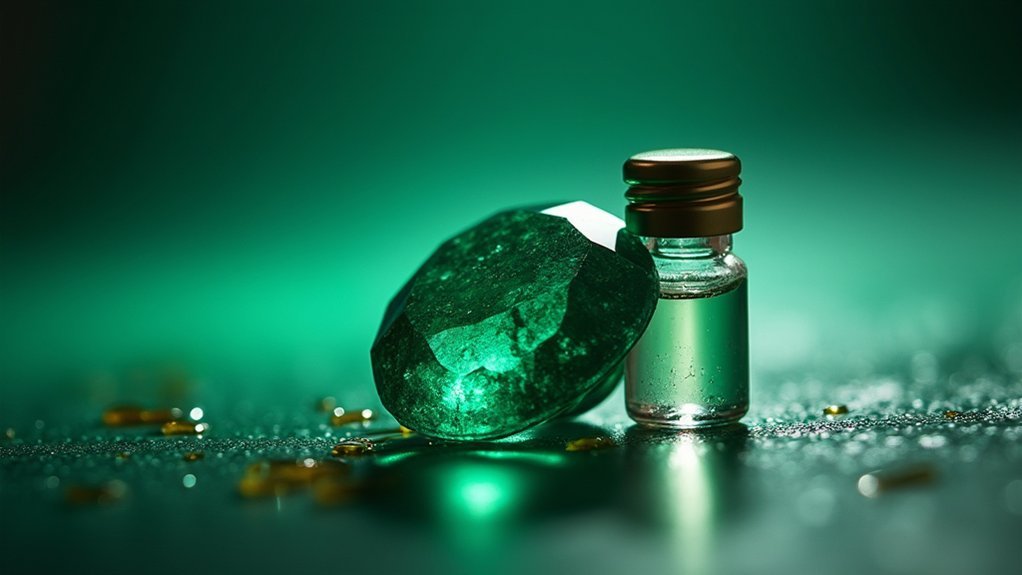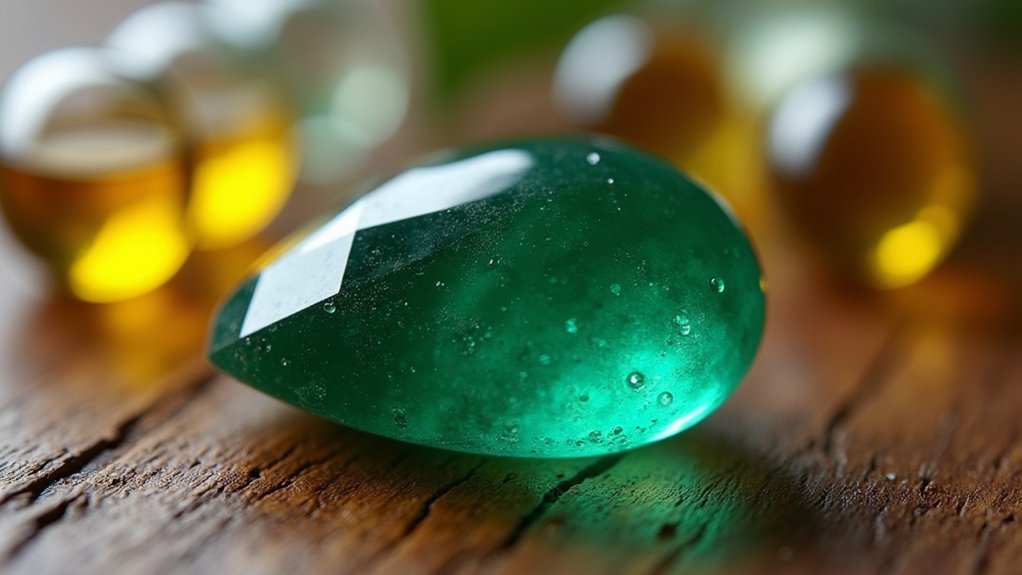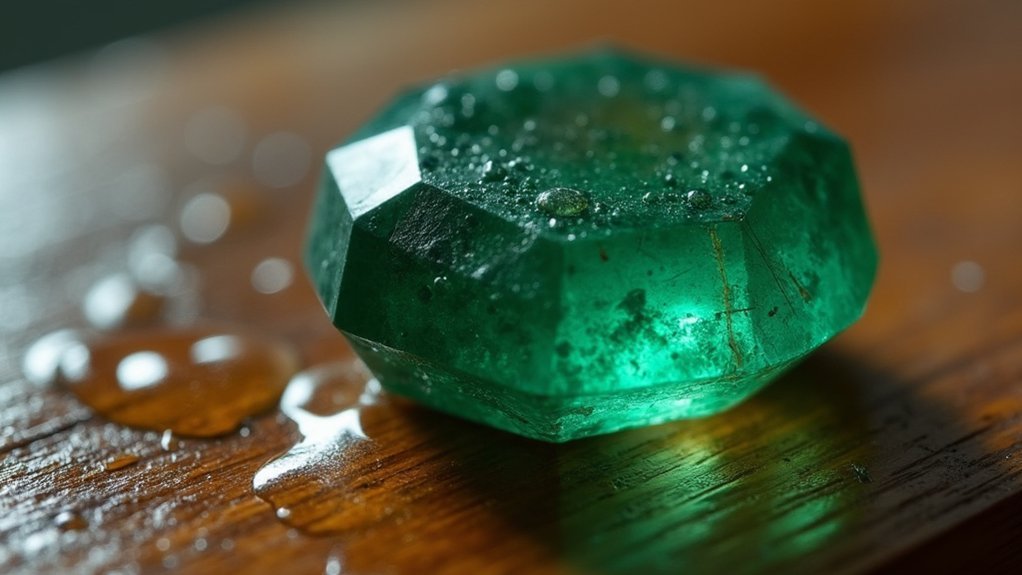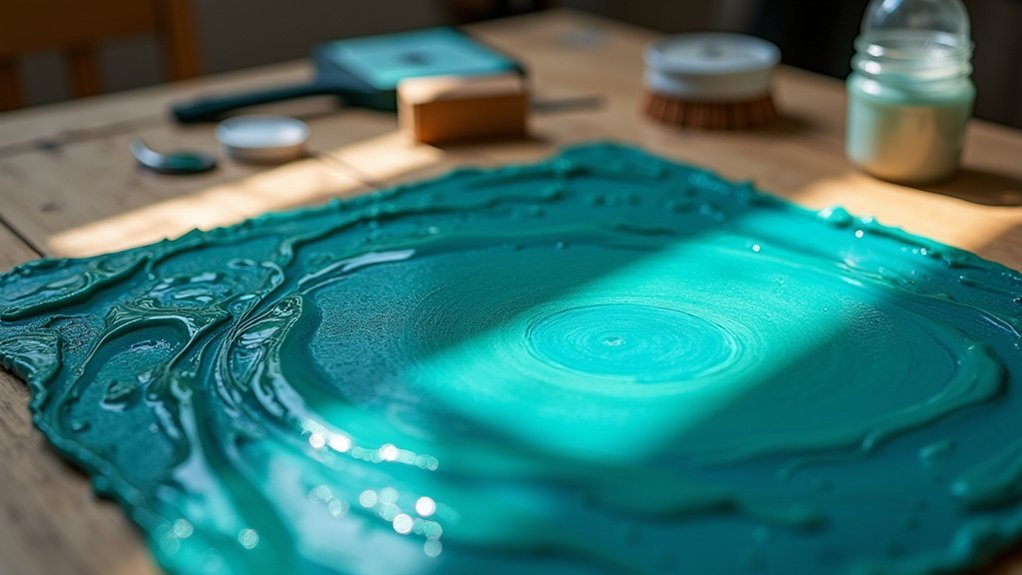You’re discovering a time-honored tradition where Colombian emerald artisans use cedar oil to enhance their precious stones’ natural beauty. This ancient practice, rooted in Incan and Aztec civilizations, involves filling surface fractures with traditional oils like cedarwood or Canada balsam to improve clarity and visual appeal. The cedar oil treatment remains the industry standard, utilizing vacuum chambers for deep penetration into fissures. Continue exploring to uncover the intricate techniques that transform raw emeralds into luminous masterpieces.
Historical Origins of Emerald Oiling Practices

Since ancient civilizations recognized emeralds’ inherent beauty, they’ve developed techniques to enhance these precious stones’ natural appeal.
You’ll find that oiling emeralds traces back to the Incas and Aztecs, who used simple vegetable oils to improve their stones’ appearance. This emerald treatment evolved greatly during the Renaissance, when gem cutting advances and expanding trade networks refined these enhancement methods.
You can appreciate the historical significance of these practices through their continuous evolution. Traditional oils like cedarwood oil and Canada balsam became industry standards in the 1980s, proving their effectiveness.
Today’s Colombian emeralds benefit from both these time-tested methods and modern synthetic resins that offer superior stability. These ancient techniques reveal how cultures have consistently valued enhancing natural beauty while preserving emeralds’ inherent magnificence.
Traditional Oils and Ancient Enhancement Methods
You’ll find that ancient civilizations like the Incas and Aztecs pioneered emerald enhancement using simple vegetable oils to improve their gems’ appearance.
These early methods laid the groundwork for today’s sophisticated oiling techniques, though the oils themselves were basic compared to modern standards.
The traditional oils that emerged over centuries—cedarwood oil, linseed oil, and Canada balsam—became the foundation of emerald treatment practices you still see today.
Ancient Civilization Methods
Although modern oiling techniques dominate today’s emerald enhancement industry, the practice traces its roots back thousands of years to ancient civilizations like the Incas and Aztecs, who first discovered that simple vegetable oils could remarkably improve their precious green stones’ clarity.
These early gem enthusiasts didn’t have access to sophisticated enhancement methods, yet they understood that natural oils could penetrate fractures within emeralds and considerably enhance their visual appeal.
You’ll find it fascinating that these ancient civilizations developed their oiling techniques through experimentation and observation.
They’d apply readily available vegetable oils to their emeralds, watching as the stones transformed before their eyes.
This primitive yet effective approach laid the foundation for today’s emerald enhancement practices, proving that innovation often springs from necessity and careful observation of natural phenomena.
Traditional Oil Types
When ancient civilizations began experimenting with emerald enhancement, they naturally turned to the oils readily available in their environment, establishing a tradition that would persist for millennia.
You’ll find that traditional oils used in Colombian emerald enhancement include three primary types: cedarwood oil, linseed oil, and Canada balsam. Each serves a specific purpose in the enhancement process.
Cedarwood oil became the industry standard after the 1980s due to its ideal viscosity and transparency. When emeralds undergo this treatment, the oil penetrates surface fractures to enhance clarity considerably.
Linseed oil and Canada balsam offer similar benefits, all chosen for their compatible refractive indices. These traditional methods directly impact market value, as properly oiled emeralds display improved visual appeal while maintaining gemological integrity.
The Sacred Cedar Oil Treatment Process

Since Colombian emeralds contain natural micro-fissures that can diminish their clarity, the sacred cedar oil treatment process has become the industry standard for enhancing these precious gemstones without compromising their inherent beauty.
Cedar oil treatment has evolved into the gemstone industry’s preferred method for enhancing Colombian emerald clarity while maintaining their authentic natural characteristics.
This traditional method, standardized in the 1980s, utilizes cedar oil’s unique viscosity and transparency properties to effectively fill surface-reaching cracks.
You’ll find the treatment process follows these essential steps:
- Preparation: Cut and polish emeralds before treatment begins
- Vacuum Chamber: Remove air from fissures to allow deep cedar oil penetration
- Heat and Pressure: Apply controlled conditions for ideal oil absorption
The microscopic volume of cedar oil used won’t add significant weight to your emeralds while preserving their natural color.
Understanding Treatment Levels and Classifications
When you’re evaluating oiled Colombian emeralds, you’ll encounter a standardized classification system that categorizes treatments as minor, moderate, or significant based on the extent of crack filling and clarity enhancement.
You’ll need to understand these treatment levels because they directly impact the emerald’s value, durability, and care requirements.
You should also expect proper disclosure of treatment classifications, as reputable dealers must provide this information to guarantee transparent and ethical purchasing decisions.
Treatment Classification System
- Minor Treatment: Only a few cracks are filled, resulting in subtle improvements while preserving the emerald’s natural characteristics and durability.
- Moderate Treatment: A greater number of fractures receive treatment, creating more common market specimens that balance beauty with structural integrity.
- Significant Treatment: Numerous visible cracks are filled, indicating potential durability concerns that often make buyers hesitant.
Additionally, emeralds treated with synthetic resins receive separate classification, offering enhanced stability and longevity compared to traditional oils requiring periodic re-treatment.
Disclosure Requirements Standards
While treatment classification provides the technical framework for understanding emerald enhancements, proper disclosure requirements guarantee you’ll receive complete transparency about your stone’s actual condition.
When purchasing an emerald, you’re entitled to know the specific oil treatment level—whether minor, moderate, or significant. This information directly impacts the stone’s value, durability, and care requirements.
Reputable dealers must disclose whether your emerald has undergone clarity enhancement through fissure filling. Without proper disclosure, you can’t make informed decisions about pricing or maintenance needs.
Transparency standards protect you from overpaying for heavily treated stones marketed as lightly enhanced gems. Always request written documentation detailing the treatment type and extent, ensuring you understand exactly what you’re purchasing and its long-term implications.
Modern Synthetic Resins Vs Natural Oil Applications

Since the 1980s, synthetic resins have revolutionized emerald enhancement by offering superior stability and longevity compared to traditional natural oils like cedarwood oil.
When you’re considering treatment options for your Colombian emeralds, you’ll find that modern synthetic resins provide several advantages over natural oils:
- Refractive Index Matching: Modern synthetic resins perfectly match emerald’s clarity requirements without affecting color perception.
- Durability: The treatment used with synthetic resins eliminates the need for re-oiling every few years.
- Maintenance: Unlike natural oils that degrade over time, synthetic resins offer long-term stability.
Your choice between these methods reflects balancing authenticity with practicality.
Choosing emerald treatments means weighing traditional authenticity against modern practicality and long-term performance benefits.
While natural oils provide a traditional approach to enhance emerald’s natural beauty, synthetic resins deliver superior performance and minimize ongoing maintenance requirements for your precious gemstones.
Detection and Identification of Oiled Emeralds
When you’re evaluating Colombian emeralds, proper detection and identification of oiling requires specialized gemological techniques that go far beyond visual inspection alone.
Microscopic analysis reveals oil presence in surface-reaching fractures, appearing as glossy sheens or fills within cracks. You’ll need advanced techniques like Raman spectroscopy and FTIR to differentiate between natural inclusions and oil treatments effectively.
Leading laboratories including GIA, SSEF, and Gübelin provide extensive reports specifying clarity treatments and oiling intensity levels. They classify treatments as minor, moderate, or significant, helping you assess enhancement extent and durability concerns.
When examining Colombian stones, you should also watch for the distinctive Gota de Aceite effect under magnification. This unique optical phenomenon requires careful evaluation to confirm its presence in oiled emeralds.
Proper Care and Maintenance of Enhanced Stones

Once you’ve identified oiling in your Colombian emerald through proper gemological testing, maintaining the stone’s enhanced beauty requires specific care protocols that differ considerably from untreated gems.
The oils used in treatment can degrade over time, making proper care essential for these enhanced stones.
Follow these maintenance guidelines:
- Clean gently with mild soapy water and soft, lint-free cloths—never use ultrasonic or steam cleaners
- Re-oil every two years to maintain their clarity and brilliance as treatments naturally deteriorate
- Store separately in soft pouches to prevent scratching from other jewelry
You’ll need to protect your emerald from harsh chemicals and extreme temperatures, which can compromise the oil treatment’s integrity and affect the stone’s appearance and longevity markedly.
Market Value Impact of Oiling Treatments
Although oiling treatments enhance Colombian emeralds’ visual appeal, they create a significant price disparity in the gemstone market.
Oiling treatments boost emerald beauty but dramatically widen the gap between treated and untreated stone prices.
You’ll find oiled emeralds starting around $1,000 per carat, while untreated “No Oil” stones command $10,000 or more per carat. The level of treatment directly affects market value—minor oiling treatments have less impact on pricing compared to significant treatments, which buyers perceive as creating fragility.
You can sell oiled emeralds faster due to their improved marketability and visual attractiveness.
However, transparency remains essential for maintaining consumer trust and perceived value. When you don’t fully disclose oiling treatments, it leads to buyer skepticism and lower resale prices.
The exceptional rarity of untreated emeralds creates a premium market segment that further stratifies treated versus natural stones.
Preservation of Colombian Emerald Heritage Through Enhancement

Since ancient civilizations like the Incas and Aztecs first discovered Colombian emeralds, oiling treatments have served as both enhancement and preservation method for these precious stones.
You’re witnessing a practice that’s evolved from simple vegetable oils to sophisticated synthetic resins, maintaining emeralds’ cultural legacy while protecting their physical integrity.
Through careful enhancement, you’re preserving Colombia’s emerald heritage by:
- Maintaining structural integrity – Oiling prevents surface-reaching cracks from expanding, ensuring these treasured gems survive for future generations.
- Honoring traditional practices – Modern techniques respect ancient methods while improving effectiveness and longevity.
- Supporting cultural continuity – Enhanced emeralds remain accessible in luxury markets, keeping Colombian gemstone traditions alive.
When you choose properly disclosed, oil-treated Colombian emeralds, you’re participating in centuries-old preservation traditions that safeguard these precious cultural artifacts.
Frequently Asked Questions
What Does Oiling Emeralds Do?
You’ll enhance your emerald’s clarity by filling surface cracks with oil, typically cedarwood oil. This process improves light transmission, increases brilliance, deepens color, and makes your gemstone more visually appealing without altering its natural characteristics.
Why Are Emeralds Oiled Before Leaving the Mine?
You’ll find emeralds are oiled before leaving mines to enhance their clarity and appearance by filling surface cracks. This traditional practice increases their market value and makes them more appealing to buyers.
What Is so Special About Colombian Emeralds?
You’ll find Colombian emeralds possess unmatched vibrant green color from chromium and vanadium. They’re prized for exceptional clarity, unique jardin inclusions, and rich cultural heritage spanning centuries of mining excellence.
How Can You Tell if an Emerald Has Been Oiled?
You can examine the emerald under magnification for glossy surface-reaching fractures, perform a water test, or get certification from gemological laboratories like GIA that’ll indicate whether it’s undergone oiling treatment.
In Summary
You’ll find that Colombian emerald oiling isn’t just about enhancement—it’s about preserving centuries of tradition. When you’re evaluating these gems, you’re witnessing an ancient craft that’s evolved alongside modern gemology. Whether you’re collecting or investing, understanding oiling treatments helps you make informed decisions. You’re not just buying a stone; you’re acquiring a piece of Colombian heritage that’s been carefully maintained through time-honored practices.




Leave a Reply